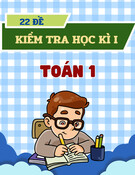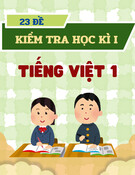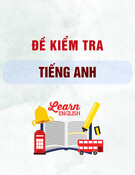
Trang 1/4 - Mã đề thi 405
SỞ GIÁO DỤC VÀ ĐÀO TẠO
NGHỆ AN
ĐỀ THI CHÍNH THỨC
(Đề thi có 04 trang)
KỲ KHẢO SÁT CHẤT LƯỢNG KẾT HỢP THI THỬ
LỚP 12 – ĐỢT 1, NĂM HỌC 2020 - 2021
Bài thi: TIẾNG ANH
Thời gian làm bài: 60 phút; không kể thời gian phát đề
Họ và tên thí sinh:....................................................................
Số báo danh: ............................................................................
Mark the letter A, B, C, or D on your answer sheet to indicate the sentence that best combines each pair of
sentences in the following questions.
Question 1: Every day the diversity of life on Earth gets poorer. We are overusing resources and disregarding the
riches of nature.
A. Every day the diversity of life on Earth gets poorer, in return for overusing resources and disregarding the
riches of nature.
B. Every day the diversity of life on Earth gets poorer, leading to overusing resources and disregarding the riches
of nature.
C. Although we are overusing resources and disregarding the riches of nature, the diversity of life on Earth gets
poorer every day.
D. The diversity of life on Earth gets poorer every day because of our overuse of resources and disregard for the
riches of nature
Question 2: The man wanted to get some fresh air in the room. He opened the window.
A. The man opened the window in order to get some fresh air in the room.
B. The man got some fresh air in the room, even though he opened the window.
C. The man wanted to get some fresh air in the room because he opened the window.
D. Having opened the window, the room could get some fresh air.
Mark the letter A, B, C, or D on your answer sheet to indicate the sentence that is closest in meaning to
each of the following questions.
Question 3: “I haven’t been very open-minded,” said the manager.
A. The manager admitted not having been very open-minded.
B. The manager denied having been very open-minded.
C. The manager promised to be very open-minded.
D. The manager refused to have been very open-minded.
Question 4: When he picked up my book he found that the cover had been torn.
A. Picked up, he saw that the cover of the book was torn.
B. The cover had been torn when his book is picked up.
C. Picking up his book, the cover had been torn.
D. On picking up the book, he saw that the cover had been torn.
Question 5: They believe that burning fossil fuels caused high levels of air pollution in this city.
A. It is believed that burning fossil fuels caused high levels of air pollution in this city.
B. Air pollution is believed to have caused high levels of air pollution in this city.
C. It is believed that high levels of air pollution caused burning fossil fuels.
D. Burning fossil fuels is believed to cause high levels of air pollution in this city.
Mark the letter A, B, C, or D on your answer sheet to indicate the underlined part that needs correction in
each of the following questions.
Question 6: It’s time you went home, but I’d rather you stay here.
A B C D
Question 7: The duties of the secretary are to take the minutes, mailing the correspondence and calling the
A B C
members before the meetings.
D
Question 8: Most of the Egyptian woman Hypatia’s writings on medicine have been lost, but there are an amount
A B C
of references to them by other scientists.
D
Read the following passage and mark the letter A, B, C, or D on your answer sheet to indicate the correct
answer to each of the questions from 9 to 15.
The first year of life
The Danish archaeologist Christian Jürgensen Thomsen, curator of the National Museum of Denmark
(1816–65), was among the first to use the taxonomic approach in the social sciences. In a painstaking study of the
Mã đề thi 405

Trang 2/4 - Mã đề thi 405
bracteate, a type of ancient pendant found in northern Europe, he charted a variety of morphological categories,
such as insignia and size. By combining the typologies thus created, he showed that these Nordic ornaments had
developed from earlier Roman coins. Thomsen later used similar techniques with a much larger body of data and
eventually developed the basic chronology for Old World antiquities: the Stone Age, Bronze Age, and Iron Age.
Ideas and expressive culture also proved susceptible to taxonomic analysis. The American ethnologist
Lewis Henry Morgan gathered data from a large number of Native American tribes and created a typology based
on their kinship terminology, which he presented in Systems of Consanguinity and Affinity of the Human Family
(1871). Influenced by the evolutionary theses of Charles Darwin and Herbert Spencer and by Thomsen's three-age
system, Morgan later proposed a universal sequence of cultural evolution in his book Ancient Society; or,
Researches in the Lines of Human Progress from Savagery Through Barbarism to Civilization (1877). In this work
he suggested that all cultures went through a clearly defined series of evolutionary stages: first savagery, which
was characterized by a hunting and gathering economy; next barbarism, the stage at which agriculture appears;
and finally civilization, represented by hierarchical societies such as those of ancient Greece, ancient Rome, and
Victorian England.
As one might suspect from Morgan's choice of terms, 19th-century social sciences were intrinsically linked
to the colonial endeavours of the period. This was the case whether the colonial effort took place domestically, as
in the United States and Canada, or abroad, as it did for the countries of Europe. Although the labeling of a group
as “savage” or “barbarous” was to some extent intended to convey specific technical information, the use of such
easily misinterpreted labels also made the era's overtly racist colonial policies more palatable to the general public:
it was considerably less morally taxing to “civilize the savages” than to “forcibly assimilate an indigenous people.”
One of the principal preoccupations of social scientists at this time was the recording of “vanishing” indigenous
cultures. This was often undertaken as part of a frank pursuit of the knowledge needed to achieve social and
political control over a region, whether in domestic or in overseas contexts. Thus, many early ethnographies and
cultural geographies were written by civil servants, military personnel, or missionaries.
Question 9: Christian Jürgensen Thomsen was one of the first scientists to ______.
A. use the scientific process of classifying things in his sudy of the social sciences
B. manage the National Museum of Denmark
C. study the bracteate, a type of ancient pendant found in northern Europe
D. study Nordic ornaments and Roman coins
Question 10: The word “painstaking” in the paragraph 1 is closest in meaning to ______.
A. complete B. thorough C. comprehensive D. complex
Question 11: According to the passage, the taxonomic approach ______.
A. likely had a base for Native American tribes’ kinship terminology
B. was intrinsically linked to the colonial endeavours of the period
C. possibly had an influence on ideas and expressive culture
D. was influenced by the evolutionary theses of Charles Darwin
Question 12: Some labels in Morgan's choice of terms ______.
A. received a lot of negative publicity during the early days of colonialism
B. made the general public believe that the colonists’ policies of racism were immoral
C. were the principal preoccupations of social scientists in the turning of 19th century
D. made the colonists’ policies of racism more acceptable to the general public
Question 13: The word “those” in paragraph 2 refers to ______.
A. series B. societies C. stages D. cultures
Question 14: The social scientists in 19th century paid most of their attention to ______.
A. the ways to assimilate an indigenous people B. the social and political control over a colony
C. Morgan's choice of terms D. the recording of “vanishing” indigenous cultures
Question 15: Civil servants, military personnel, or missionaries wrote many ethnographies and cultural
geographies of a country ______.
A. so as to store information about indigenous cultures for later generations
B. in an endeavour to achieve social and political control over it
C. as part of a frank pursuit of the knowledge needed for their research
D. in order to justify their overtly racist colonial policies
Read the following passage and mark the letter A, B, C, or D on your answer sheet to indicate the correct
answer to each of the questions from 16 to 20.
When naming a child, some parents seem to choose a name based simply on their personal preference. In
other families, grandparents or professional name-makers come up with a child’s name. And in some cases, the
time of a child’s birth influences how the child’s name is determined.
In many European cultures, names are typically chosen by parents. Parents’ choice for their child’s name
may be based on names of relatives or ancestors within their particular family. For example, in Italy, children are
traditionally named after their grandparents. The parents generally use the father’s parents’ names first. If they
have more children, then they will use the mother’s parents’ names. Similarly, some people in Eastern Europe
name their children after relatives who have died. This tradition is seen as a means to protect the child from the
Angel of Death.

Trang 3/4 - Mã đề thi 405
Traditionally in some Asian countries, a child’s grandfather or a fortune-teller chooses the child’s name. In
contrast to the tradition of naming children after relatives, the child’s name is chosen to influence the child’s
character. For example, names may be based on a connection to certain elements such as fire, water, earth, wood,
or metal. Or the name might include a written character meaning beauty, strength, or kindness.
In certain African cultures, when a child is born plays a large part in determining the child’s name. In Ghana’s Akan
culture, the day a child is born determines the child’s name. But each day has different names for boys and girls.
For instance, a boy born on Friday is named Kofi, whereas a girl born on the same day is named Afua. Both Kofi
and Afua are names meaning “wanderer” or “explorer.” Children with these names are seen as travelers. No matter
where the name comes from, a child’s name is the first gift in life. Whether it is chosen according to preference or
dictated by tradition, the name reflects something about a child’s culture. For that reason, all names should be
treasured and respected.
Question 16: What is the main idea of this reading?
A. How names reflect a person’s culture B. Choosing traditional names
C. Choosing names in Italian culture D. How Asian people name their children
Question 17: In which culture are children most likely named after their grandparents?
A. Japanese B. Italian C. Akan D. Mexican
Question 18: In China, what should names relate to?
A. A child’s ancestors B. A child’s personality
C. A child’s birth date D. A child’s birth element
Question 19: Which is true in Akan culture if a twin brother and sister are born on a Friday?
A. They will both be named Kofi. B. They will both be named Afua.
C. They will have to travel to a different city. D. They will have different names.
Question 20: The word “dictated” in paragraph 4 is closest in meaning to ______.
A. determined B. translated C. said D. written
Read the following passage and mark the letter A, B, C, or D on your answer sheet to indicate the correct
word or phrase that best fits each of the numbered blanks from 21 to 25.
PENICILLIN BEFORE PENTIUMS FOR THE POOR
One of the hottest topics on the international development agenda is how to harness the power of ICT for
the benefit of developing countries. What is sometimes called ‘the death of distance’, brought about by the
(21)______, allows professional services such as software, education and training to be provided easily and quickly
to (22)______ areas. Some of the gains can be seen in countries as diverse as India and Morocco, where
innovations range from online government announcements to local craftsmen selling their wares to a (23)______
market. But already a huge and expanding digital divide is opening up between developed and developing nations.
The major task facing world leaders at present is to (24)______ everybody on the planet with clean water, basic
education and the drugs needed to fight preventable diseases. Installing a modem in every classroom and linking
us all to cyberspace must be a lesser (25)_______, for the time being at least.
Question 21: A. modem B. internet C. telephone D. computer
Question 22: A. uninhabited B. remote C. secluded D. far
Question 23: A. village B. global C. shrinking D. technical
Question 24: A. supply B. give C. donate D. administer
Question 25: A. criteria B. importance C. priority D. advantage
Mark the letter A, B, C, or D on your answer sheet to indicate the option that best completes each of the
following exchanges.
Question 26: Jenny and Jimmy are talking about university education.
Jenny: “I think having a university degree is the only way to succeed in life.”
Jimmy: “ ______. There are successful people without a degree.”
A. That's life B. That's all right C. I don’t quite agree D. I can’t agree more
Question 27: John is having dinner at Linda’s house.
John: “This roast beef is so delicious.”
Linda: “______”
A. I’m glad you like it. B. No, don’t worry. C. I don’t, either. D. Sure, I’d love to.
Mark the letter A, B, C, or D to indicate the word that is OPPOSITE in meaning to the underlined part in
each of the following questions.
Question 28: I felt a strong smell of perfume among the women at the party.
A. shabby B. weak C. faint D. awkward
Question 29: My children sided with their mother whenever we had an argument.
A. were against B. were for C. were supportive D. were tolerant of

Trang 4/4 - Mã đề thi 405
Mark the letter A, B, C, or D on your answer sheet to indicate the word(s) CLOSEST in meaning to the
underlined word(s) in each of the following questions.
Question 30: As children we were very close, but as we grew up we just drifted apart.
A. were not as serious as before B. became less sympathetic than before
C. were not as childlike as before D. became less friendly than before
Question 31: We heard the sound of an approaching car, so we ran away.
A. coming B. moving C. running D. breaking
Mark the letter A, B, C, or D on your answer sheet to indicate the word that differs from the other three in
the position of primary stress in each of the following questions.
Question 32: A. attend B. maintain C. conquer D. confide
Question 33: A. engagement B. company C. furniture D. vacancy
Mark the letter A, B, C, or D on your answer sheet to indicate the correct answer to each of the following
questions.
Question 34: The more you relax and be yourself, the more ______ you are to succeed.
A. easy B. possible C. probable D. likely
Question 35: In my family, all members are responsible ______ doing the household chores.
A. with B. for C. on D. at
Question 36: My English friend wasn’t used to ______ chopsticks when he came to Vietnam last year.
A. uses B. used C. have used D. using
Question 37: The weather has been terrible since yesterday. ______, all activities have stopped.
A. Therefore B. So that C. Because D. Now that
Question 38: Nowadays, children would prefer history ______ in more practical ways.
A. to teach B. teach C. to be taught D. being taught
Question 39: Tea is ranked as the number one beverage ______ worldwide, it takes the lead over coffee in both
popularity and production.
A. to sell B. selling C. to have sold D. sold
Question 40: She got a terrible mark in the exam, so she ______ very hard at all.
A. mustn’t have worked B. can’t work C. can’t have worked D. didn’t need to work
Question 41: All the students have been ready for the test, ______?
A. hasn’t they B. have they C. don’t they D. haven’t they
Question 42: You can’t always play it safe. Sometimes you need to ______ a risk.
A. have B. make C. take D. put
Question 43: With my working-class background I feel like a ______ out of water among the high-society people.
A. shark B. dolphin C. crocodile D. fish
Question 44: Recently I haven't got ______.
A. many mails B. much mail C. many mail D. any mails
Question 45: As a teacher she was very selectively accepting only a small number of _______ gifted pupils.
A. exceptionally B. exception C. exceptional D. unexceptionally
Question 46: Deborah is going to take extra lessons to ______ what she missed while she was away.
A. put up with B. catch up on C. take up with D. cut down on
Question 47: We do not need much furniture ______ the room is small.
A. because of B. although C. because D. despite
Question 48: I think I ______ my door key. I can’t find it anywhere.
A. had lost B. will lose C. have lost D. am losing
Mark the letter A, B, C, or D on your answer sheet to indicate the word whose underlined part differs from
the other three in pronunciation in each of the following questions.
Question 49: A. prepare B. celebrate C. entertain D. protect
Question 50: A. watched B. laughed C. moved D. pressed
-----------------------------------------------
----------- THE END ----------






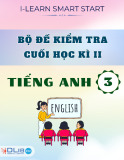
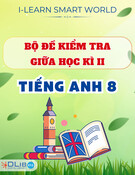
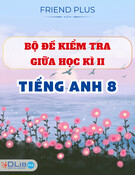
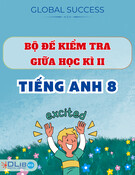
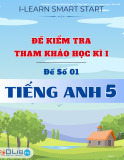

![Đề thi Tiếng Anh có đáp án [kèm lời giải chi tiết]](https://cdn.tailieu.vn/images/document/thumbnail/2025/20250810/duykpmg/135x160/64731754886819.jpg)
